
НУВИК 3000 МЕ ПОРОШОК И РАСТВОРИТЕЛЬ ДЛЯ ПРИГОТОВЛЕНИЯ ИНЪЕКЦИОННОГО РАСТВОРА
Спросите врача о рецепте на НУВИК 3000 МЕ ПОРОШОК И РАСТВОРИТЕЛЬ ДЛЯ ПРИГОТОВЛЕНИЯ ИНЪЕКЦИОННОГО РАСТВОРА

Инструкция по применению НУВИК 3000 МЕ ПОРОШОК И РАСТВОРИТЕЛЬ ДЛЯ ПРИГОТОВЛЕНИЯ ИНЪЕКЦИОННОГО РАСТВОРА
Введение
Инструкция: информация для пользователя
Nuwiq 250 UI порошок и раствор для инъекционного раствора
Nuwiq 500 UI порошок и раствор для инъекционного раствора
Nuwiq 1000 UI порошок и раствор для инъекционного раствора
Nuwiq 2000 UI порошок и раствор для инъекционного раствора
Nuwiq 2500 UI порошок и раствор для инъекционного раствора
Nuwiq 3000 UI порошок и раствор для инъекционного раствора
Nuwiq 4000 UI порошок и раствор для инъекционного раствора
симоктоког альфа (рекомбинантный человеческий фактор свёртывания VIII)
Прочитайте внимательно всю инструкцию перед началом использования этого лекарства, поскольку она содержит важную информацию для вас.
- Сохраните эту инструкцию, поскольку вам может потребоваться прочитать её снова.
- Если у вас есть какие-либо другие вопросы о использовании этого лекарства, обратитесь к вашему врачу.
- Это лекарство было назначено только вам, и не передавайте его другим людям, даже если у них такие же симптомы, как у вас, поскольку это может нанести им вред.
- Если вы испытываете побочные эффекты, обратитесь к вашему врачу, даже если это побочные эффекты, которые не указаны в этой инструкции. См. раздел 4.
Содержание инструкции
- Что такое Nuwiq и для чего он используется
- Что вам нужно знать перед началом использования Nuwiq
- Как использовать Nuwiq
- Возможные побочные эффекты
- Хранение Nuwiq
- Содержание упаковки и дополнительная информация
1. Что такое Nuwiq и для чего он используется
Nuwiq содержит активное вещество рекомбинантный человеческий фактор свёртывания VIII (симоктоког альфа). Фактор VIII необходим для того, чтобы кровь образовывала сгустки и останавливала кровотечение. У пациентов с гемофилией А (врождённым дефицитом факторов VIII) фактор VIII отсутствует или не функционирует правильно.
Nuwiq заменяет отсутствующий фактор VIII и используется для лечения и профилактики кровотечений у пациентов с гемофилией А и может быть использован во всех возрастных группах.
2. Что вам нужно знать перед началом использования Nuwiq
Не используйте Nuwiq:
- если вы аллергичны к активному веществу симоктокогу альфа или к любому другому компоненту этого лекарства (указанному в разделе 6).
Если вы не уверены, обратитесь к вашему врачу.
Предостережения и меры предосторожности
Обратитесь к вашему врачу или медсестре перед началом использования Nuwiq.
Существует небольшая вероятность того, что вы испытаете анафилактическую реакцию (внезапную тяжёлую аллергическую реакцию) на Nuwiq. Вы должны уметь распознавать ранние симптомы аллергических реакций, которые включены в раздел 4 "Аллергические реакции".
Если出现 любой из этих симптомов, немедленно прекратите инъекцию и обратитесь к вашему врачу.
Образование ингибиторов (антител) является известной осложнением, которое может возникнуть во время лечения всеми препаратами, содержащими фактор VIII. Эти ингибиторы, особенно в больших количествах, препятствуют правильному функционированию лечения, поэтому вас и вашего ребёнка будут тщательно контролировать на предмет развития таких ингибиторов. Если кровотечение или кровотечение вашего ребёнка не контролируется с помощью Nuwiq, немедленно обратитесь к вашему врачу.
Сердечно-сосудистые события
У пациентов с факторами риска сердечно-сосудистых заболеваний заместительная терапия FVIII может увеличить сердечно-сосудистый риск.
Осложнения, связанные с катетерами
Если вам требуется центральный венозный доступный устройство (CVAD), необходимо учитывать риск осложнений, связанных с CVAD, включая локальные инфекции, бактериемию и тромбоз в месте имплантации катетера.
Рекомендуется вести учёт каждого введения Nuwiq, чтобы поддерживать связь между вами и партией лекарства.
Использование Nuwiq с другими лекарствами
Сообщите вашему врачу, если вы используете, недавно использовали или можете использовать любое другое лекарство.
Беременность и лактация
Если вы беременны или кормите грудью, считаете, что можете быть беременной или планируете стать беременной, обратитесь к вашему врачу перед использованием этого лекарства.
Вождение и использование машин
Nuwiq не влияет на способность управлять транспортными средствами и работать с машинами.
Nuwiq содержит натрий
Это лекарство содержит менее 1 ммоль натрия (23 мг) на флакон, что означает, что оно практически не содержит натрия.
Однако, в зависимости от вашего веса и дозировки, вам может быть введено более одного флакона, что следует учитывать, если вы придерживаетесь диеты с низким содержанием натрия.
3. Как использовать Nuwiq
Лечение Nuwiq будет начато врачом с опытом ухода за пациентами с гемофилией А. Следуйте точно инструкциям по введению этого лекарства, указанным вашим врачом или медсестрой. В случае сомнений обратитесь к вашему врачу или медсестре.
Nuwiq обычно вводится в вену (внутривенно) вашим врачом или медсестрой с опытом ухода за пациентами с гемофилией А. Вы сами или другой человек также можете вводить Nuwiq, но только после получения соответствующей подготовки.
Ваш врач рассчитает вашу дозу Nuwiq (в Международных единицах = МЕ) в зависимости от вашего состояния, веса и того, используется ли он для профилактики или лечения кровотечений. Частота введения будет зависеть от того, насколько хорошо Nuwiq действует на вас. Обычно лечение гемофилии А является пожизненным.
Профилактика кровотечений
Обычная доза Nuwiq составляет 20-40 МЕ/кг веса тела, вводимая каждые 2-3 дня. Однако в некоторых случаях, особенно у более молодых пациентов, могут быть необходимы более частые инъекции или более высокие дозы.
Лечение кровотечений
Доза Nuwiq рассчитывается в зависимости от вашего веса и уровня факторов VIII, которые необходимо достичь. Целевые уровни факторов VIII будут зависеть от тяжести и местоположения кровотечений.
Если вы считаете, что эффект Nuwiq недостаточен, обратитесь к вашему врачу. Ваш врач проведёт необходимые лабораторные анализы, чтобы убедиться, что у вас есть достаточные уровни факторов VIII. Это особенно важно, если вам предстоит крупная операция.
Пациенты, entwickивающие ингибиторы факторов VIII
Если уровень факторов VIII в вашей плазме не достигает ожидаемых значений с помощью Nuwiq или если кровотечения не контролируются должным образом, это может быть связано с развитием ингибиторов факторов VIII. Ваш врач проверит это. Вам может потребоваться более высокая доза Nuwiq или другой препарат для контроля кровотечений. Не увеличивайте общую дозу Nuwiq для контроля кровотечений без консультации с вашим врачом.
Использование у детей и подростков
Способ использования Nuwiq у детей и подростков не отличается от способа использования у взрослых. Поскольку может быть необходимо чаще вводить препараты факторов VIII детям и подросткам, может быть необходимо использовать центральный венозный доступный устройство (CVAD). CVAD представляет собой внешний коннектор, который позволяет получить доступ к кровотоку через катетер без инъекции через кожу.
Если вы используете больше Nuwiq, чем необходимо
Не было зарегистрировано никаких симптомов передозировки. Если вы ввели больше Nuwiq, чем необходимо, сообщите об этом вашему врачу.
Если вы пропустили использование Nuwiq
Не принимайте двойную дозу, чтобы компенсировать пропущенную дозу. Введите следующую дозу немедленно и продолжайте использовать препарат согласно рекомендациям вашего врача.
Если вы прекратите лечение Nuwiq
Не прекращайте лечение Nuwiq без консультации с вашим врачом.
Если у вас есть какие-либо другие вопросы о использовании этого лекарства, обратитесь к вашему врачу.
4. Возможные побочные эффекты
Как и все лекарства, это лекарство может вызывать побочные эффекты, хотя не все люди испытывают их.
Аллергические реакции
Вы должны уметь распознавать ранние симптомы аллергических реакций. Если возникают тяжёлые аллергические реакции (анафилактические) внезапно (очень редко, могут возникать у 1 из 10 000 человек), необходимо немедленно прекратить инъекцию. Обратитесь немедленно к вашему врачу, если вы заметите любой из следующих симптомов:
- сыпь, крапивница, зуд,
- отёк губ и языка,
- затруднение дыхания, свистящее дыхание, чувство сжатия в груди,
- общее чувство недомогания,
- головокружение и потеря сознания.
Эти симптомы могут быть ранними признаками анафилактического шока. Если возникает любой из этих симптомов, немедленно прекратите инъекцию и обратитесь к вашему врачу. Тяжёлые симптомы требуют немедленного лечения.
Очень частые побочные эффекты, которые могут возникать у более 1 из 10 человек
Ингибиторы FVIII у пациентов без предыдущего лечения.
У детей и подростков, не получавших ранее лечения препаратами факторов VIII, могут возникать ингибиторы (см. раздел 2) очень часто (более 1 из 10 пациентов).
Однако у пациентов, получавших ранее лечение фактором VIII (более 150 дней лечения), риск является редким (менее 1 из 100 пациентов). Если это происходит, лекарства, которые принимаете вы или ваш ребёнок, могут перестать действовать правильно, и вы или ваш ребёнок можете испытать постоянное кровотечение. В этом случае немедленно обратитесь к вашему врачу.
Частые побочные эффекты, которые могут возникать у до 1 из 10 человек
Гиперчувствительность, лихорадка.
Редкие побочные эффекты, которые могут возникать у до 1 из 100 человек
Онемение или покалывание (парестезия), головная боль, воспаление и/или боль в месте инъекции, боль в спине, головокружение, сухость во рту, геморрагическая анемия, положительные результаты образования ненейтрализующих антител (в ПТП).
Сообщение о побочных эффектах
Если вы испытываете побочные эффекты, обратитесь к вашему врачу или фармацевту или медсестре, даже если это побочные эффекты, которые не указаны в этой инструкции. Вы также можете сообщить об этом напрямую через национальную систему уведомления, указанную в Приложении V. Сообщая о побочных эффектах, вы можете внести свой вклад в предоставление более полной информации о безопасности этого лекарства.
5. Хранение Nuwiq
Храните это лекарство в недоступном для детей месте.
Не используйте это лекарство после даты истечения срока годности, указанной на этикетке упаковки и флакона после аббревиатуры EXP. Дата истечения срока годности является последним днём месяца, указанного.
Храните в холодильнике (при температуре от 2°C до 8°C). Не замораживайте. Храните флакон в оригинальной упаковке, чтобы защитить его от света.
До того, как Nuwiq порошок будет восстановлен, его можно хранить при комнатной температуре (до 25°C) в течение одного периода, не превышающего 1 месяц. Запишите дату, с которой начнёте хранить Nuwiq при комнатной температуре, на упаковке лекарства. Не храните Nuwiq в холодильнике после того, как он был хранен при комнатной температуре.
Используйте восстановленный раствор сразу после восстановления.
Предупреждения о видимых признаках повреждения
Не используйте это лекарство, если вы заметите видимые признаки повреждения упаковки, особенно шприца и/или флакона.
Лекарства не должны выбрасываться в канализацию или мусор. Спросите вашего фармацевта, как утилизировать упаковку и лекарства, которые вам больше не нужны. Таким образом, вы поможете защитить окружающую среду.
6. Содержание упаковки и дополнительная информация
Состав Нувика
Порошок:
- Активное вещество - рекомбинантный человеческий фактор VIII свертывания крови (симоктоког альфа). Каждая ампула с порошком содержит 250, 500, 1000, 2000, 2500, 3000 или 4000 МЕ симоктокога альфа.
Каждый восстановленный раствор содержит примерно 100, 200, 400, 800, 1000, 1200 или 1600 МЕ/мл симоктокога альфа.
- Другие компоненты - сахароза, хлорид натрия, дигидрат хлорида кальция, аргинин гидрохлорид, дигидрат цитрата натрия и полоксамер 188. См. раздел 2, "Нувиq содержит натрий".
Растворитель:
Вода для инъекций
Внешний вид Нувика и содержание упаковки
Нувиq поставляется в виде порошка и растворителя для инъекционного раствора. Порошок белого или почти белого цвета находится в стеклянной ампуле. Растворитель - вода для инъекций в предварительно заполненной стеклянной шприце.
После восстановления раствор прозрачный, бесцветный и свободен от посторонних частиц.
Каждая упаковка Нувика содержит:
- 1 ампулу с порошком, содержащую 250, 500, 1000, 2000, 2500, 3000 или 4000 МЕ симоктокога альфа
- 1 предварительно заполненную шприц с 2,5 мл воды для инъекций
- 1 адаптер для ампулы
- 1 игла-бабочка
- 2 ватных шарика с алкоголем
Владелец разрешения на маркетинг и производитель
Octapharma AB, Lars Forssells gata 23, 112 75 Стокгольм, Швеция
Для получения любой информации о этом лекарственном средстве, свяжитесь с местным представителем владельца разрешения на маркетинг:
Бельгия/Белгique/Бельгия Octapharma Benelux (Бельгия) Тел: +32 2 3730890 | Литва Octapharma Nordic AB (Швеция) Тел: +46 8 56643000 |
Латвия Octapharma Nordic AB (Швеция) Тел: +46 8 56643000 | Люксембург/Люксембург Octapharma Benelux (Бельгия) Тел: +32 2 3730890 |
Чехия Octapharma CZ s.r.o. Тел: +420 266 793 510 | Венгрия Octapharma Nordic AB (Швеция) Тел: +46 8 56643000 |
Дания Octapharma Nordic AB (Швеция) Тел: +46 8 56643000 | Мальта Octapharma Nordic AB (Швеция) Тел: +46 8 56643000 |
Германия Octapharma GmbH Тел: +49 2173 9170 | Нидерланды Octapharma Benelux (Бельгия) Тел: +32 2 3730890 |
Эстония Octapharma Nordic AB (Швеция) Тел: +46 8 56643000 | Норвегия Octapharma AS Тел: +47 63988860 |
Греция Octapharma Hellas SA Тел: +30 210 8986500 | Австрия Octapharma Handelsgesellschaft m.b.H. Тел: +43 1 610321222 |
Испания Octapharma S.A. Тел: +34 91 6487298 | Польша Octapharma Poland Sp. z o.o. Тел: +48 22 2082734 |
Франция Octapharma France Тел: +33 1 41318000 | Португалия Octapharma Produtos Farmacêuticos Lda. Тел: +351 21 8160820 |
Хорватия Octapharma Nordic AB (Швеция) Тел: +46 8 56643000 | Румыния Octapharma Nordic AB (Швеция) Тел: +46 8 56643000 |
Ирландия Octapharma AB (Швеция) Тел: +46 8 56643000 | Словения Octapharma Nordic AB (Швеция) Тел: +46 8 56643000 |
Исландия Octapharma AS (Норвегия) Тел: +47 63988860 | Словакия Octapharma AG, o.z.z.o. Тел: +421 2 54646701 |
Италия Kedrion S.p.A. Тел: +39 0583 767507 | Финляндия Octapharma Nordic AB Тел: +358 9 85202710 |
Кипр Octapharma Nordic AB (Швеция) Тел: +46 8 56643000 | Швеция Octapharma Nordic AB Тел: +46 8 56643000 |
Латвия Octapharma Nordic AB (Швеция) Тел: +46 8 56643000 | Великобритания Octapharma Limited Тел: +44 161 8373770 |
Дата последнего пересмотра этой инструкции
Подробная информация о этом лекарственном средстве доступна на сайте Европейского агентства по лекарственным средствам: http://www.ema.europa.eu.
Эта информация предназначена только для медицинских специалистов:
Лечение по требованию
Доза и частота введения должны всегда определяться исходя из клинической эффективности в каждом отдельном случае.
При следующих геморрагических эпизодах активность фактора VIII не должна быть ниже указанного уровня активности плазмы (в % от нормы или МЕ/мл) в соответствующий период. Ниже приведена таблица, которая может быть использована в качестве руководства для дозирования при хирургии и геморрагических эпизодах.
Степень геморрагии/тип хирургического вмешательства | Требуемый уровень фактора VIII (%) (МЕ/мл) | Частота доз (часов)/продолжительность лечения (дней) |
Геморрагия | ||
Начало гемартроза, мышечная или ротовая геморрагия | 20-40 | Повторять каждые 12-24 часа. Не менее 1 дня до тех пор, пока эпизод геморрагии, как указано на боли, не будет разрешен или не наступит выздоровление. |
Более обширный гемартроз, мышечная геморрагия или гематома | 30-60 | Повторять инфузию каждые 12-24 часа, в течение 3-4 дней или более, пока боль и острая инвалидность не прекратятся. |
Потенциально смертельная геморрагия | 60-100 | Повторять инфузию каждые 8-24 часа до тех пор, пока опасность не минует |
Хирургия | ||
Малая хирургия, включая удаление зубов | 30-60 | Каждые 24 часа, не менее 1 дня, до выздоровления. |
Большая хирургия | 80-100 (до и после операции) | Повторять инфузию каждые 8-24 часа до тех пор, пока не будет достигнуто адекватное заживление раны, и затем не менее 7 дней лечения для поддержания активности фактора VIII на уровне 30-60% (МЕ/мл). |
ИНСТРУКЦИИ ПО ПОДГОТОВКЕ И ПРИМЕНЕНИЮ
- Дайте шприцу с растворителем (вода для инъекций) и порошку достичь комнатной температуры в закрытой ампуле. Для этого можно держать их в руках до тех пор, пока они не достигнут температуры рук. Не нагревайте ампулу и предварительно заполненную шприц никаким другим способом. Эта температура должна поддерживаться во время восстановления.
- Удалите защитную пластиковую крышку с ампулы с порошком, чтобы открыть центральную часть резиновой пробки. Не удаляйте серую пробку или металлическое кольцо, окружающее верхнюю часть ампулы.
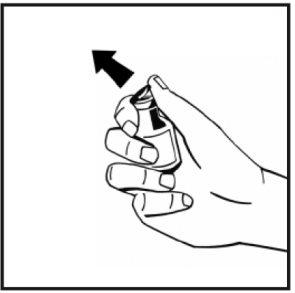
- Очистите верхнюю часть ампулы ватным шариком с алкоголем. Дайте алкоголю высохнуть.
- Удалите бумажную упаковку с адаптера ампулы. Не удаляйте адаптер из упаковки.
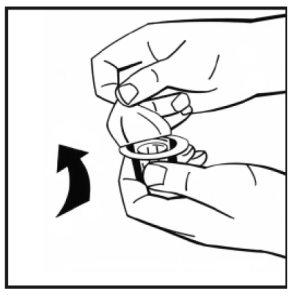
- Поместите ампулу с порошком на ровную поверхность и удерживайте ее. Возьмите упаковку адаптера и поместите адаптер ампулы на центр резиновой пробки ампулы с порошком. Надавите на упаковку адаптера вниз до тех пор, пока кончик адаптера не пройдет через резиновую пробку. Адаптер будет присоединен к ампуле, когда это будет сделано.
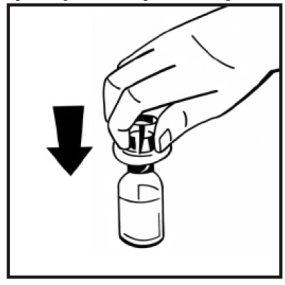
- Удалите бумажную упаковку с предварительно заполненной шприц. Держите шток поршня шприц за конец и не трогайте ось. Присоедините резьбовой конец штока поршня к поршню шприца с растворителем. Поверните шток поршня по часовой стрелке до тех пор, пока не почувствуете легкое сопротивление.
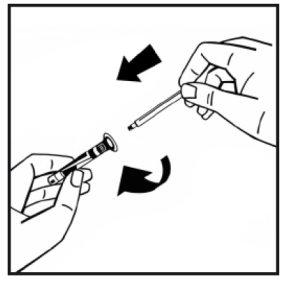
- Разломайте пластиковую защитную насадку на конце шприца с растворителем, сломав перфорацию на крышке. Не трогайте внутреннюю часть крышки или кончик шприца. Если вы не будете использовать раствор сразу, закройте наполненный шприц пластиковой защитной насадкой для хранения.
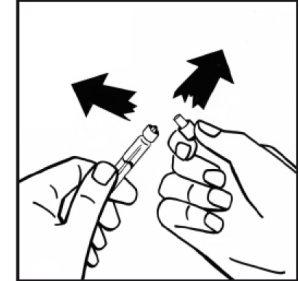
- Удалите упаковку адаптера и выбросьте ее.
- Присоедините шприц с растворителем к адаптеру ампулы, повернув по часовой стрелке до тех пор, пока не почувствуете легкое сопротивление.
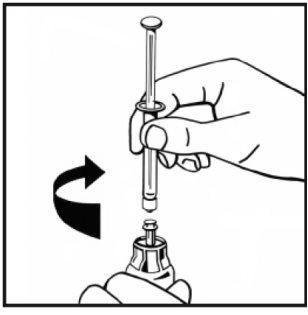
- Медленно введите весь растворитель в ампулу с порошком, нажимая шток поршня вниз.
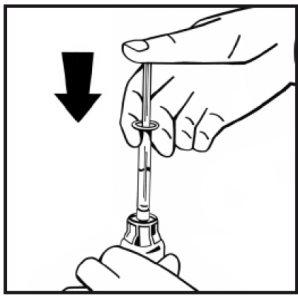
- Не удаляя шприц, осторожно перемешайте ампулу вращательными движениями несколько раз, чтобы растворить порошок. Не встряхивайте. Подождите, пока весь порошок полностью не растворится.
- Проверьте, есть ли частицы в окончательном растворе перед введением. Раствор должен быть прозрачным, бесцветным и практически свободным от видимых частиц. Не используйте мутные или осадочные растворы.
- Переверните ампулу, присоединенную к шприцу, и медленно извлеките раствор в шприц. Убедитесь, что весь объем ампулы был перенесен в шприц.
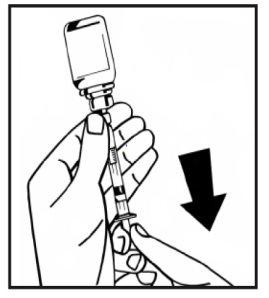
- Отделите наполненный шприц от адаптера ампулы, повернув против часовой стрелки, и выбросьте пустую ампулу.
- Раствор готов к immediate использованию. Не охлаждайте.
- Очистите выбранное место для инъекции ватным шариком с алкоголем.
- Присоедините комплект для инъекции, поставляемый с шприцем.
Введите иглу комплекта для инъекции в выбранную вену. Если вы использовали жгут, чтобы сделать вену более видимой, он должен быть ослаблен перед началом введения раствора.
Кровь не должна попасть в шприц из-за риска образования фибриновых сгустков.
- Введите раствор в вену медленно, не быстрее 4 мл в минуту.
Если вы используете более одной ампулы с порошком для лечения, вы можете использовать ту же иглу снова. Адаптер ампулы и шприц являются одноразовыми.
- Страна регистрации
- Активное вещество
- Требуется рецептДа
- Производитель
- Информация носит справочный характер и не является медицинской рекомендацией. Перед приемом любых препаратов проконсультируйтесь с врачом. Oladoctor не несет ответственности за медицинские решения, принятые на основе этого контента.
- Аналоги НУВИК 3000 МЕ ПОРОШОК И РАСТВОРИТЕЛЬ ДЛЯ ПРИГОТОВЛЕНИЯ ИНЪЕКЦИОННОГО РАСТВОРАФорма выпуска: ИНЪЕКЦИОННЫЙ РАСТВОР, 1000 МЕАктивное вещество: фактор свертывания крови VIIIПроизводитель: Takeda Manufacturing Austria AgТребуется рецептФорма выпуска: ИНЪЕКЦИОННЫЙ РАСТВОР, 1500 МЕАктивное вещество: фактор свертывания крови VIIIПроизводитель: Takeda Manufacturing Austria AgТребуется рецептФорма выпуска: ИНЪЕКЦИОННЫЙ РАСТВОР, 1000 МЕ - после восстановления в 2 мл воды для инъекций доза составляет 500 МЕ/млАктивное вещество: фактор свертывания крови VIIIПроизводитель: Takeda Manufacturing Austria AgТребуется рецепт
Аналоги НУВИК 3000 МЕ ПОРОШОК И РАСТВОРИТЕЛЬ ДЛЯ ПРИГОТОВЛЕНИЯ ИНЪЕКЦИОННОГО РАСТВОРА в других странах
Лучшие аналоги с тем же действующим веществом и терапевтическим эффектом.
Аналог НУВИК 3000 МЕ ПОРОШОК И РАСТВОРИТЕЛЬ ДЛЯ ПРИГОТОВЛЕНИЯ ИНЪЕКЦИОННОГО РАСТВОРА в Poland
Аналог НУВИК 3000 МЕ ПОРОШОК И РАСТВОРИТЕЛЬ ДЛЯ ПРИГОТОВЛЕНИЯ ИНЪЕКЦИОННОГО РАСТВОРА в Ukraine
Врачи онлайн по НУВИК 3000 МЕ ПОРОШОК И РАСТВОРИТЕЛЬ ДЛЯ ПРИГОТОВЛЕНИЯ ИНЪЕКЦИОННОГО РАСТВОРА
Консультация по дозировке, побочным эффектам, взаимодействиям, противопоказаниям и продлению рецепта на НУВИК 3000 МЕ ПОРОШОК И РАСТВОРИТЕЛЬ ДЛЯ ПРИГОТОВЛЕНИЯ ИНЪЕКЦИОННОГО РАСТВОРА – по решению врача и с учетом местных правил.














